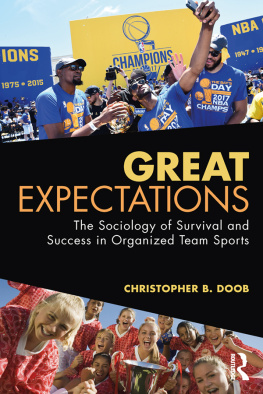Great Expectations
In Great Expectations: The Sociology of Survival and Success in Organized Team Sports, sociological analysis proves to be a powerful ally for grasping how the sports world unfolds for team players, providing a range of sociological ideas and concepts that extend throughout the book. The text boxes and class discussion sections help summarize key issues, linking important sociological concepts to the topics at hand. The eight chapters begin with an introduction and then detail athletes activities at different stages in their development.
Christopher B. Doob is professor emeritus of sociology at Southern Connecticut State University. His published works include Sociology: An Introduction, 6th Edition (1999); Social Inequality and Social Stratification in U.S. Society (2012); Race, Ethnicity, and the Urban American Mainstream (2004); and Racism: An American Cauldron, 3rd Edition (1998), the second edition of which received a Myers Center Award for the Study of Human Rights. In addition, Doob has been active in his community, serving as coordinator for the Southern Connecticut State Universitys Urban Initiatives, which established math tutoring classes for inner-city children. He has also participated in the struggle for welfare rights and been a long-time volunteer in two local adult education programs.
First published 2018
by Routledge
711 Third Avenue, New York, NY 10017
and by Routledge
2 Park Square, Milton Park, Abingdon, Oxon, OX144RN
Routledge is an imprint of the Taylor & Francis Group, an informa business
2018 Taylor & Francis
The right of Christopher B. Doob to be identified as author of this work has been asserted by him in accordance with sections 77 and 78 of the Copyright, Designs and Patents Act 1988.
All rights reserved. No part of this book may be reprinted or reproduced or utilised in any form or by any electronic, mechanical, or other means, now known or hereafter invented, including photocopying and recording, or in any information storage or retrieval system, without permission in writing from the publishers.
Trademark notice: Product or corporate names may be trademarks or registered trademarks, and are used only for identification and explanation without intent to infringe.
Library of Congress Cataloging-in-Publication Data
A catalog record for this book has been requested
ISBN: 978-1-138-48892-2 (hbk)
ISBN: 978-1-138-48896-0 (pbk)
ISBN: 978-1-351-03902-4 (ebk)
Typeset in Adobe Caslon by
Servis Filmsetting Ltd, Stockport, Cheshire
This book examines the modern American sports world and its team programs for different levels of players. Elite participants involved in team sports are the primary focus, beginning with organized activities for young children and continuing to the professional ranks. These athletes undertake a journey, varying in length from short, even abruptly so, to sometimes as much as several decades in length.
At each level of advancement, the necessity of survival forces athletes to face more formidable competition along with the frequent risk of injury, burnout, or disruptive relations with coaches, teammates, and (at the youth level) parents.
Organized sports often develop in a pressure-laden context, with about 70 percent of young athletes leaving programs by the age of 13, primarily because of burnout. Survivors face an intimidating numbers gamefour or fewer chances in 100 of high-school athletes joining a Division I program in a popular sport and a miniscule one chance in 1,000 of reaching the majors. The few who attain the big leagues in the most popular sports have short careers, about three to five years. The overall prospects are forbidding, and yet large numbers of parents, coaches, and the young athletes themselves commit to the demanding prospect of school sports, local programs, travel teams, and tournaments, fervently striving for big-time success.
Once I discussed the quest for fame and fortune in sports with an experienced pediatrician who had witnessed numerous parents encouraging or pressuring their children to succeed at the Division I or pro levels. I asked him if the parents realized what a long shot they are promoting. The numbers are so daunting, he said, that they simply avoid a realistic look. In the upcoming chapters, ample evidence bolsters that conclusion.
Sociological analysis proves helpful in understanding such responses to sports programs. The renowned sociologist C. Wright Mills asserted that the field of sociology enables us to grasp history and biography and the relations between the two within society (Mills 1959, 6). Millss reference to history was a broad one, including in the upcoming volume history in the conventional sense but also incorporating other contextual influences like community, family, coaches, teachers, and teammates along with such individual traits as athletes age, gender, race, ethnicity, and social class. The historical dimension recognizes that since the middle of the 20th century national and local political and economic leadership has often promoted an expanded role for organized sports, with an enlarged emphasis on winning and the development of elite programs often linked to such commercial enterprises as shoe and apparel companies, travel teams, and out-of-school tournaments and, of course, revenue-expanding college and professional teams.
Since entering sociology I have found Millss perspective useful, and as a result the introduction and the following five chapters begin with an historical section that provides some background for and insight into contemporary sports programming and then in each case follows up with what Mills considered biographical material examining the factors influencing modern athletes involvement in organized sports programs.
The introduction contains a general framework for athletes in organized team sports, featuring three stages players encounter within a given sports program. Succinct references to these stages sometimes appear in the subsequent five chapters, which cover different levels of organized sports. In addition, individual chapters mostly introduce a concept or idea that proves useful in guiding the analysis of the subject at hand.
The 11 sports included in the book are for males football, baseball, basketball, hockey, soccer, and lacrosse and for females basketball, fastpitch softball, volleyball, soccer, and lacrosse. From youth programs to the pro level, these are arguably the most popular sports. For instance, all five of the female sports are included in the top ten most frequently played in high school, and five of the six male sports possess established pro leagues that are two decades or older in duration.
Besides the number and level of sports covered, the text supplies extensive coverage of research from several disciplines, case-study material, survey data, photos, and detailed references to players that should make reading it both enjoyable and stimulating, promoting retention of the material as well as a grasp of the relationship between sociological concepts and ideas and players experiences. The tables, boxes, and suggestions for class discussion pinpoint key issues, sometimes linking important sociological concepts to the topics at hand.
There are eight chapters, beginning with an introduction and then detailing athletes activities at different stages in their development. In addition, one chapter focuses on athletes who unexpectedly became stars and another on retired pros lives. The book offers a distinctive perspective on players thoughts and actions as they strive to survive and succeed in organized sports.









